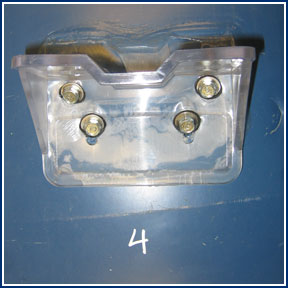Testing
The Truth About Test Results
Professional Testing
At SnoBlox-SnoJax we take pride in our product test results. Each model has been tested by Architectural Testing, Inc., the most respected name in building envelope testing. We hope you will agree that our tests are the most practical and conclusive and the results speak for themselves. Click each image for a larger picture.
"At SnoBlox-SnoJax we have applied our 40 plus years of snow retention experience to developing quality snow guards that pass the test of time. Part of the reason our snow guards are so dependable is because not only are they designed and built to work and last, but we will not stop testing and improving our products until we are certain they deserve the SnoBlox-SnoJax name." -Brion McMullen, President / CEO
Please take a moment to look over the actual ATI test results.
| Snow Guard Model | Adhesive Results* | Mechanical Results* |
| SnoBlox Ace | 1449 Lbs. | 4849 Lbs. |
| SnoBlox Deuce | 1379 Lbs | 3456 Lbs. |
| SnoJax I | NA (screw down only) | 1800 Lbs. |
| SnoJax II | 700 Lbs. | 3750 Lbs. |
| IceJax I | 500 Lbs. | 4200 Lbs. |
| IceJax II | 1561 Lbs. | 6388 Lbs. |
| Metal SnowCatcher | NA (screw down only) | 3923 Lbs. |
| Mustang SnowCatcher | NA (screw down only) | 4149 Lbs. |
| SunBurst SnowCatcher | NA (screw down only) | 3945 Lbs. |
| FleurDeLis SnowCatcher | NA (screw down only) | 4128 Lbs. |
| Maple Leaf SnowCatcher | NA (screw down only) | 4366 Lbs. |
*The release point on all testing procedures was in the “Method of Attachment”. |
||
We would like to encourage you to consider the value of professional testing as opposed to the truck test. Our products were designed to work and have been professionally tested, truck tested and field tested to work.
The Test Apparatus
The tests performed on each model of snow guard simulate actual and realistic snow loads and weight conditions. We tested each guard by applying pressure via the steel rod, simulating weight, while measuring the force of the load against its face. Our tests simulate actual snow load shear conditions unlike other competitors snow guard testing that pulls upward on the face of the guard, a force that is never found on a snowy, icy roof. We also found it necessary to only perform static laboratory testing since our 20 plus years of unbeaten track record using the SB-190 clearly speaks for itself!
Flush Mount
The test presses on the face of the guard where the snow load is greatest, simulating real snow load conditions. Please note that all our guards have a forward mounted flat face designed to form a strong holding field across the entire roof to retain the snow & ice until it can safely melt away.
Impressive Results
We were impressed to find that when we were done testing, each guard was still intact and the release was directly attributed to screw failure or release of the mounting method, not because of a structural failure by the guard. This image was taken after this guard had just held 6388 Lbs, notice how its only disfigurement is where the screws broke and dug into the guard.
The Truck Test
You can see why this test lacks validity as the tire, despite being at full pressure, engulfed the guard. The truck test is as much a test of the tire as it is of the snow guard, fortunately for us, both passed with flying colors.
IceJax I
We tested both methods of attachment, adhesive mount with SureBond SB-190 and mechanical mount with # 14 SS screws & silicone. We have also tested additional alternative tapes, adhesives and sealants but have not been pleased with the results or longevity of any other variety of snow guard adhesion. The SureBond SB-190 repeatedly provided optimal holding power and is time proven since we first pioneered its use for our polycarbonate Snojax II snow guards in 1985.
Metal Snow Guards
The improved 16 gauge 304 grade stainless steel construction of the Metal SnowCatchers performed very well during testing, each guard was still intact and the release was directly attributed to screw failure or release of the mounting method, not because of a structural failure by the guard.
SnoBlox Ace
Once more we put our guards to the test, only this time instead of calibrated lab equipment, we used an F-150. We lowered the truck all the way so that each guard was exposed to the full weight of the truck.
IceJax II
When the test was complete and we had lifted the truck once again, each guard was intact and presentable. Although we are glad the truck test went well, we do realize that the forces applied by lowering a truck on a snow guard are unrealistic and impractical.








